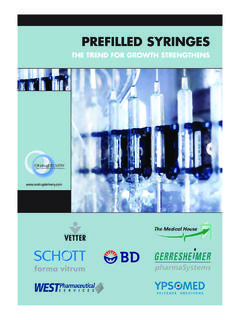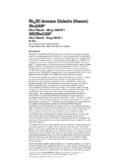Transcription of DATA SHEET XYNTHA - Medsafe
1 data S H E ET XYNTHA moroctocog alfa (rch) (recombinant coagulation factor VIII) NAME OF THE MEDICINE XYNTHA moroctocog alfa (rch) 250, 500, 1000, 2000 IU powder for injection vial. XYNTHA moroctocog alfa (rch) 250, 500, 1000, 2000, 3000 IU powder for injection in a prefilled dual chamber syringe. DESCRIPTION XYNTHA contains moroctocog alfa (rch) (cho), also known as recombinant coagulation factor VIII. Moroctocog alfa rch is a purified protein produced by recombinant DNA technology for use in therapy of factor VIII deficiency (haemophilia A or classic haemophilia). XYNTHA is a purified glycoprotein with an approximate molecular mass of 170 kDa, consisting of 1438 amino acids, which does not contain the non-functional B-domain. The amino acid sequence of moroctocog alfa is comparable to the 90 + 80 kDa form of factor VIII.
2 (The post-translat ional modifications and in vitro functional characteristics of moroctocog alfa are comparable to those of endogenous factor VIII). Morocotocog alfa is secreted by a genetically engineered Chinese hamster ovary (CHO) cell line. The CHO cell line has been extensively studied and found to be free of detectable viruses. The cell line is grown in a chemically defined cell culture medium that does not contain any materials derived from human or animal sources. The purification process has been refined to affinity purify moroctocog alfa using a column chromatography method that employs chemically synthesised affinity ligand, replacing the murine monoclonal antibody Sepharose resin and eliminating a potential risk of viral contamination associated with murine monoclonal antibody and its manufacture.
3 Because XYNTHA is not purified from human blood and is manufactured from a well-characterised cell line in the absence of human- or animal-derived materials, it minimises the risk of transmission of human blood-borne pathogens, such as human immunodeficiency virus (HIV), hepatitis viruses and parvovirus. The viral safety profile is further enhanced by the inclusion of a solvent-detergent viral inactivation step and a virus-retaining nanofiltration step during purification. The protein is purified by a chromatography purification process that yields a high-purity, active product. The potency expressed in International Units (IU) is determined using the chromogenic assay of the European Pharmacopoeia. The Wyeth manufacturing reference standard for potency has been calibrated against the World Health Organisation (WHO) International Standard for factor VIII activity using the one-stage clotting assay.
4 The specific activity of XYNTHA is 5500 to 9900 IU per mg protein. XYNTHA is formulated as a sterile, non-pyrogenic, lyophilised powder for intravenous (IV) injection. It is available in single use vials and in single use prefilled dual chamber syringes containing the labelled amount of factor VIII activity, expressed in IUs. Each vial contains nominally 250, 500, 1000 or 2000 IU of XYNTHA per vial. Each prefilled dual chamber syringe contains nominally 250, 500, 1000, 2000 or 3000 IU of XYNTHA per syringe. The product reconstituted with 4 mL Sodium Chloride Diluent (9 mg/mL ( ) is a clear colourless Version: pfdxyntv11216 Supersedes: pfdxyntv10416 Page 1 of 13 solution, containing sodium chloride, sucrose, L-histidine, calcium chloride dihydrate, and polysorbate 80. Each vial/ prefilled syringe of XYNTHA contains mmol (or 29 mg) sodium, to be taken into consideration by patients on a controlled sodium diet.)
5 PHARMACOLOGY Actions XYNTHA is a recombinant DNA-based substance, which has functional characteristics comparable to those of endogenous factor VIII. Activated factor VIII acts as a cofactor for activated factor IX accelerating the conversion of factor X to activated factor X. Activated factor X converts prothrombin into thrombin. Thrombin then converts fibrinogen into fibrin and a clot is formed. Factor VIII activity is greatly reduced in patients with haemophilia A. Administration of XYNTHA increases plasma levels of factor VIII activity and can temporarily correct the coagulation defect in these patients. Pharmacokinetics In a pivotal cross-over clinical study, the pharmacokinetics of XYNTHA was compared to another recombinant factor VIII product (rFVIII, Advate *) in 30 previously treated patients ( 12 years) following a single infusion of 50 IU/kg.
6 The 90% confidence intervals for the mean AUC0- ratio of XYNTHA to Advate was shown to be within the bioequivalence range of 80-125% using the one stage assay to measure factor VIII levels. In a 6-month fo llow-up assessment in 25 patients, the pharmacokinetic profile of XYNTHA was comparable between baseline and month 6 (see Table 1). The 90% confidence intervals for the 6 mo nth-to-baseline ratios of mean K-value and AUC0- were both within the equivalence range of 80-125%, suggesting negligible time dependent changes in the pharmacokinetic properties of XYNTHA . Table 1: Pharmacokinetic Parameter Estimates for XYNTHA at Baseline and Month 6 in Previously Treated Patients with Haemophilia A. Visit Cmax (IU/mL) AUC0- (IU hr/mL) T (hr) CL (mL/hr/kg) Vss (mL/kg) K-value (IU/dL per IU/kg) Recovery (%) Baseline Mean SD 105 19 (Min, Max) ( , ) ( , ) ( ; ) ( ; ) ( ; ) ( , ) ( , 132) Month 6 Mean SD * 116 40 (Min, Max) ( , ) ( , ) ( ; ) ( ; ) ( ; ) ( , ) ( , 256) Abbreviations: AUC0- = area under the plasma concentration-time curve from time zero to infinity; Cmax = peak concentration; CL= clearance; Vss=Steady date volume of distribution; K-value = incremental recovery; SD = standard deviation; *One subject was excluded from the calculation due to lack of a well-defined terminal phase.
7 In a pivotal phase 3 study for surgical prophylaxis, XYNTHA pharmacokinetics were evaluated during the perioperative management of patients with haemophilia A who were undergoing major surgery. At the baseline visit, all patients received a single dose of XYNTHA of approximately 50 IU/kg. Plasma samples were analyzed for FVIII activity using a validated one-stage (OS) clotting method. Recovery data are available for a total of 30 patients; the mean ( standard deviation [SD]) K-value was ( ) IU/dL per IU/kg, and the mean ( SD) in vivo recovery value was ( 20%). Version: pfdxyntv11216 Supersedes: pfdxyntv10416 Page 2 of 13 In previously untreated patients (PUPs), pharmacokinetic parameters of XYNTHA manufactured by a previous process were evaluated using the chromogenic assay. These patients (n=59; median age 10 months) had a mean incremental recovery at Week 0 of IU/dL per IU/kg (range to IU/dL per IU/kg) which was lower than that obtained in PTPs at Week 0 with a mean K-value of IU/dL per IU/kg (range to IU/dL per IU/kg).
8 In the PUPs, the mean incremental recovery was stable over time (5 visits during a 2 year period) and ranged from to IU/dL per IU/kg. Population pharmacokinetic modeling using data from 44 PUPs led to a mean estimated half-life of hours. CLINICAL TRIALS In a pivotal phase 3 study, the efficacy of XYNTHA was evaluated in routine prophylaxis and on-demand treatment. Prophylaxis was to be initiated at a dose of 30 IU/kg given 3 times per week. The on-demand treatment dosing regimen was to be determined by the investigator. Ninety-four (94) PTPs with moderately severe or severe haemophilia A (FVIII:C 2%) received at least 1 dose of XYNTHA and were included in the intent-to-treat (ITT) population. Eight y-nine (89) patients accrued at least 50 exposure days (EDs) to XYNTHA in the study. Of the 94 patients in the ITT population, 30 patients with FVIII:C 1% also participated in the double-blind, randomised, crossover PK period of the study and were included in the per-protocol population for analyses of bioequivalence versus another rFVIII product, Advate , and full pharmacokinetic characterisation.
9 Both endpoints were surrogate markers for clinical efficacy. The results of these analyses show that XYNTHA is bioequivalent to Advate (using the one stage assay to measure factor VIII levels) and the pharmacokinetic profile of XYNTHA remained stable after 6 months of repeated use. Intent-to-treat analysis of clinical efficacy variables in the open-label safety and efficacy period yielded similarly positive outcomes. All 94 patients received XYNTHA for routine prophylaxis; the median dose administered was IU/kg (range to IU/kg). Most patients (57/94; ) reported no spontaneous bleeding while on routine prophylaxis. The median annualised bleeding rate (ABR) for all bleeding episodes was (mean , range 0 to ), indicating effective prevention of bleeding in the study population. Fifty-three (53) of 94 patients received XYNTHA for on-demand treatment; the median dose administered was IU/kg (range, to IU/kg).
10 The majority of bleeding episodes (173/187; ) resolved with 1 or 2 infusions. This outcome was not restricted to any particular bleeding location as similar efficacy was seen in bleeding occurring in joints, soft tissues/muscles, and other sites. A wide range of doses was used to initiate treatment of bleeding; however, the distribution of doses used to initiate treatment of bleeding was similar regardless of location of bleeding. Patients rated the majority of infusions used to initiate treatment of bleeding as either excellent or good (132 of 187; ). The incidence of less than expected therapeutic effect (LETE) occurred at a rate of (25/6404 prophylactic infusions) when XYNTHA was administered for prophylaxis and (1/187 episodes) when administered for on-demand treatment. A pivotal phase 3 study for surgical prophylaxis in patients with haemophilia A included PTPs with severe or moderately severe (FVIII:C 2%) haemophilia A undergoing major surgical procedures who received XYNTHA .














